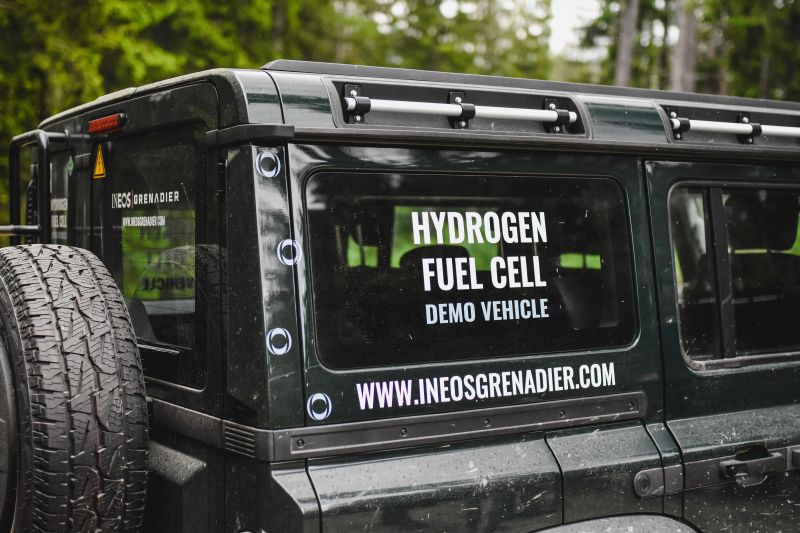Electrification is the buzzword of the industry at the moment, though Ineos Automotive sees a big opportunity for hydrogen fuel-cell vehicles in Australia’s future.
Speaking with CarExpert at the local media launch for the Grenadier 4×4, head of Ineos APAC region Justin Hocevar said the company’s global parent is a huge player in the hydrogen space, which will better suit vehicles like the Grenadier as well as heavy and agricultural industries.
“When it comes to hydrogen from an automotive perspective, we’re a small player… but when it comes to hydrogen and Ineos, we’re a really big global player – in fact, amongst the biggest,” Mr Hocevar said.
“[We’re] producing over 400,000 tonnes of hydrogen a year. Now a lot of that comes from other manufacturing processes, some of it’s a byproduct; but equally we’ve got 2.2 billion euros invested in green hydrogen projects at the moment. So, it’s very close to core business and the attention of Ineos.”
“We want to be able to leverage that much bigger and broader understanding, but the infrastructure will need government impetus to try and get more infrastructure in place,” Mr Hocevar continued.
“Hydrogen is a very interesting topic for Australia. We know there are some very big and important industry sectors to the overall Australian economy that have a very keen eye and are investing in hydrogen projects.
“Whether that’s Fortescue Metals and what they’re doing with hydrogen concepts in rail, shipping, road transport and mining… We know that in agribusiness there’s some projects underway, again Fortescue has a hydrogen project that’s being developed up in Queensland.”
“Australia relies very heavily on road transport. I think that heavy road transport absolutely lends itself to hydrogen technology, more so than battery [electric vehicles]. Australia should be – my view – a global leader in setting forward a vision for the rollout in hydrogen technology, and we would love to be a part of that. We will become quite active, if we could see others pushing forward,” Mr Hocevar added.
While a more widely used fuel source in other parts of the world like Asia, hydrogen is very much a bit-player in the Australian market.
There are two hydrogen refuelling stations located in Melbourne: one owned by Toyota Australia and the other by government research agency CSIRO and Swinburne University.
There’s also a refuelling station operated by ActewAGL in Canberra.
Victoria, New South Wales and Queensland are collaborating on a renewable hydrogen refuelling superhighway to connect the country’s eastern seaboard. Toyota and Hyundai also recently signed a memorandum of understanding to work together alongside Ampol and Pacific Energy to develop hydrogen refuelling infrastructure in Australia.
There are currently two FCEVs available to Australians – the Toyota Mirai and Hyundai Nexo – which are both offered on lease agreements.
Toyota is also currently running a pilot program of HiAce van prototype with a hydrogen-fuelled internal-combustion engine (ICE) in Australia, while BMW plans to bring hydrogen-powered iX5 ‘demonstration vehicles’ to Australia early in 2024.
Earlier this year Ineos Automotive revealed a hydrogen-powered Grenadier prototype at the Goodwood Festival of Speed, designed in collaboration with Austrian engineering firm, AVL.
The prototype is powered by the BMW Group’s “latest” hydrogen FCEV powertrain, which the company claims is the “most advanced and powerful in the automotive sector”.
Ineos hasn’t provided any details or claimed outputs on the hydrogen fuel cell powertrain besides saying the electric drive units deliver “true torque vectoring drive control to each rear wheel”.
For reference, the BMW iX5 Hydrogen is powered by a single rear-mounted electric motor producing 295kW of power. It’s fed by a fuel cell stack sourced from Toyota and two 700-bar hydrogen tanks made from carbon-fibre-reinforced plastic (CFRP).
The iX5 has a claimed WLTP range of 504km and refuelling the hydrogen tanks takes three to four minutes.
Ineos claims to have undergone “rigorous testing” on the hydrogen Grenadier demonstrator to ensure there has been no compromise to its on- and off-road capabilities, as well as its towing capacities.
The demonstrator has apparently “conquered” a number of trails around the Austrian mountains and various off-road challengers around the city of Graz. The only visible external change on this Ineos Grenadier FCEV demonstrator compared to the regular model is a bulge on the bonnet to accommodate the additional height of the fuel cell.
Ineos has said the bulge on the bonnet won’t be present in the production model. Other modifications that can’t be seen include alterations to the Grenadier’s ladder-frame chassis and rear axle in order to accomodate the electric drive units.
At this stage it’s unclear if or when a production version of this hydrogen-powered Grenadier will go into production. Ineos has, however, committed to putting its first battery electric vehicle into production in 2026.
MORE: 2024 Ineos Grenadier review
MORE: Everything Ineos Grenadier



